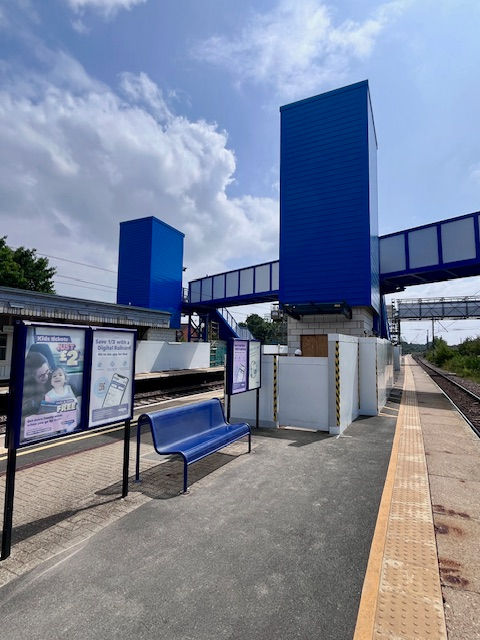Can we afford not to have an accessible railway?
- Julian Vaughan

- Jul 16, 2024
- 4 min read
On 24th May the Department for Transport announced the railway stations set to benefit from the latest round of ‘Access for All’ (AfA) funding for Control Period 7 which runs from 2024-2029. Having been part of the campaign group, I was delighted to see Leagrave station on the list. However, the £350 million allocated for step-free improvements over the next five years is significantly short of what is required to speed up the glacial progress towards a rail network that is genuinely accessible to all.
Much like safety, accessibility is repeated mantra-like by those in charge of our railway as a ‘top priority’. Both answers are equally as disingenuous. Research by the Leonard Cheshire charity found that, at the current rate of progress, the railway system won’t be fully accessible until 2070 and safety is always assessed in terms of its cost.
However, there is far more than just a financial barrier to achieving an accessible rail network. There is a deeply set culture of a ‘tick box’ approach towards accessibility and a prevailing attitude of the provision of accessibility as a favour, not a right. Even those at the top of the rail industry have admitted that they have failed disabled people.
The New Government
I am delighted that after years of chaos and incompetence we now have a Labour government. However, while of course it is very early days, I have yet to see any firm commitment to accelerating progress toward a step-free rail network. A step-free rail network is not just morally the right thing to do, it makes good financial sense too, with a guaranteed healthy return on investment. Further, it intersects with many core values and missions of the Labour Party including equality, social justice, access to work and leisure, and the drive to net zero. Further, we all benefit from a step-free railway, as taking people out of their cars and onto trains means our roads will become less congested, and parents with buggies, travellers with heavy luggage and those with reduced mobility will be able to access public transport. I have spoken to numerous people who say their family members just don’t travel because of our inaccessible rail network and this increases loneliness and social isolation.
Access for All funding to date
Access for All (AfA) funding commenced in 2006 under a Labour government and has continued under subsequent coalition and Conservative governments. It is actually rather difficult to obtain the exact figure for the funding and spending of these funds, but I have given it my best shot below. In fairness, a highly prominent disability campaigner has had their recent Freedom of Information request into the levels of funding and spending delayed due to the ‘complexity’ of providing this information! Funding for AfA is broadly broken down into Control Periods (CPs) which are five-year periods which align with the funding settlements for the UK’s rail network. There are some anomalies which I will point out.
The above table does not include additional funding from announcements made at other times, such as the £50 million announced by Rishi Sunak in the Spring 2020 budget, set to benefit the following stations, Newton, Beeston, Flitwick, Eaglescliffe, Walkden, East Grinstead, South Croydon, Eridge, Tooting.
The table also does not include extra funding announced in the 2014 Autumn statement which was set to benefit Alexandra Palace station among others. Alexandra Palace still awaits a step-free route 10 years on, although I understand completion of this project is due in 2025.
The cost of a step-free network
There is an excellent research paper published by the Leonard Cheshire charity into the costs (and benefits) of making the UK Rail Network step-free. I have included an infographic below, the full report can be read here: https://www.leonardcheshire.org/sites/default/files/2020-12/Get-on-Board-2020-policy-report.pdf
I suspect the high scenario of £5.6bn would be the most accurate figure, it could well be in excess of this, but this would still amount to approximately 3% of the total transport capital investment budget.
The financial benefits of an accessible rail network
Research into the financial benefits of Access for All funding was conducted for the Department for Transport by Steer Davies Gleave in 2015. This research set out the financial and societal returns for accessibility investment. It found an average benefit to cost ratio of 2.4 : 1. This benefit to cost ratio did not include the impact on unencumbered passengers. If they are included the benefit to cost ratio increases significantly. Additional benefits other than accessibility are also discussed, including reduced congestion on our roads, a reduction in carbon emissions and a reduction in noise and air pollution. Further, these benefits are likely to increase significantly as our population ages. According to the Office for National Statistics (January 2021), by 2050 one in four of the population will aged 65 years or over, compared to one in five today. You can read the full 2015 report from Steer Davies Gleave here: https://uk.steergroup.com/sites/default/files/2021-03/Access4AllBenefitResearch2015.pdf
Summary
As set out above, apart from being a vital aspect of social justice, enabling access to work and leisure on an equal basis, a step-free rail network makes financial sense too, particularly as we shift towards an ageing population. I would urge the current Labour government to invest in improving the accessibility of our rail network. Moving on from the gimmicks of the last government, this will be part of the real levelling up that the UK so desperately needs. The UK has a legally binding target for net zero carbon. Our rail network will play an important role in achieving this. Let’s have a legally binding target for a fully accessible rail network too!
Julian Vaughan
16th July 2024
Sources and further reading:
Network Rail – Access for All – improving accessibility at railway stations nationwide: https://www.networkrail.co.uk/communities/passengers/station-improvements/access-for-all-improving-accessibility-at-railway-stations-nationwide/
Leonard Cheshire: Get on Board 2020 – making the economic case for ‘levelling up’ inclusive transport: https://www.leonardcheshire.org/sites/default/files/2020-12/Get-on-Board-2020-policy-report.pdf
The Hendy Report November 2015: https://www.networkrail.co.uk/wp-content/uploads/2019/06/hendy-report.pdf
The Hendy Report January 2016: https://www.networkrail.co.uk/wp-content/uploads/2019/06/hendy-report.pdf






Comments